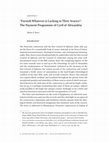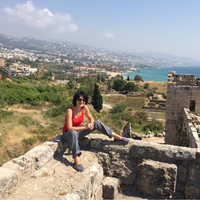Peer-Reviewed Articles and Chapters by Walter Beers

Travaux et mémoires 26: Mélanges James Howard-Johnston, 2022
This paper presents a case, informed by the historiography of subaltern studies, for the interrel... more This paper presents a case, informed by the historiography of subaltern studies, for the interrelated socioeconomic significance of the Jafnid family of Arab phylarchs and of the sixth-century Miaphysite church for the largely rural region of southern Syria/northern Jordan known as the Ḥawrān. It begins with a close reading of John of Ephesus’ “Life of Thomas the Armenian”, exploring its relevance for understanding the effects of Justinianic policy in the eastern border provinces. It then presents three strands of evidence for the situation in the Ḥawrān: 1) the information provided by John of Ephesus about the phylarch al-Mundhir b. al-Ḥārith; 2) the 137 subscriptions to the 569/70 “Letter from the abbots of Arabia” surviving in the so-called anti-tritheist dossier; 3) archaeological evidence for village life in the Ḥawrān. It is argued that the presence of large numbers of Miaphysite monks and minor clergy in the region, and the patronage offered to the struggling Miaphysite church by the Jafnid family, may have provided the peasantry of the Ḥawrān with a means of defence against the encroachments of aggressively acquisitive urban elites. A conjunction of mutually beneficial self-interest would thus have offered the Jafnids a weapon against regional rivals; the Miaphysite clergy a committed constituency and sources of economic support in the region’s village churches; and the independent peasants of the Ḥawrān a discursive expression of resistance to aristocratic accumulation.
Hypatia of Alexandria: Her Context and Legacy, ed. Dawn LaValle Norman and Alex Petkas (Mohr Siebeck), 2020
and the members of the Princeton LAMB Workshop. 2 PLRE 2:575-6, "Hypatia 1. " These events will b... more and the members of the Princeton LAMB Workshop. 2 PLRE 2:575-6, "Hypatia 1. " These events will be discussed in detail below; scholarly (and unscholarly) treatments abound, but notable recent readings include

From Constantinople to the Frontier: The City and the Cities, ed. Nicholas S.M. Matheou, Theofili Kampianaki and Lorenzo M. Bondioli (Brill), 2016
The Nestorian controversy and the rst Council of Ephesus (June-July 431) are the focus of a consi... more The Nestorian controversy and the rst Council of Ephesus (June-July 431) are the focus of a considerable body of source material, in the form of letters, imperial pronouncements, theological treatises, and contemporary historiography. Thus, these events should probably be ranked after only the later second Council of Ephesus and the Council of Chalcedon among the most welldocumented events of the fth century. Since the competing legacies of the two later councils were so tied up in the Christology of Cyril of Alexandria and the condemnation of 'Nestorianism' enshrined in the decisions of the rst Council of Ephesus, the written records of the controversy and council remained a fertile source of ammunition in the hard-fought Christological con icts of the later fth, sixth, and seventh centuries. Hence, this material was copied, edited, reedited, and translated throughout the period. Given the exceptional quantity and immediacy of these sources, most of which were produced between the early days of the controversy in 428 and its fragile resolution in 433, it is perhaps unsurprising that some of them are unique, without ready parallels in the larger late antique context. Strikingly so are a letter and attached document associated with the correspondence of Cyril. The letter and attachment are the work of Epiphanius, an otherwise unattested archidiaconus and syncellus to Cyril, and they shed light on an aspect of the controversy's negotiation and resolution entirely separate from the theological debate and rhetorical antagonism that dominate most of the sources. The letter is addressed to Maximianus, Nestorius' replacement as bishop of * My sincerest gratitude for their ever-helpful comments and guidance is due to Neil McLynn, Fergus Millar, Bryan Ward-Perkins, the anonymous readers at the University of Oxford, and most especially to Walter Stevenson, who inspired this paper-and much more besides. Acta conciliorum oecumenicorum [hereafter ], ed.
Aramaic Studies, 2016
Introduction to special issue of Aramaic Studies.
Thesis Chapters by Walter Beers

Dissertation, 2022
This dissertation uses the works of Syriac historian and hagiographer John of Ephesus as a spring... more This dissertation uses the works of Syriac historian and hagiographer John of Ephesus as a springboard to propose a new social history of the anti-Chalcedonian or Miaphysite movement, placing religious developments in the sixth-century east Roman empire for the first time within their larger socioeconomic context. In this period, Miaphysitism, a sectarian movement that originated in episcopal factionalism surrounding the Council of Chalcedon (451), lost its influence in major urban centers in favor of the pro- Chalcedonian imperial church. At the same time, Miaphysitism became increasingly dominant in many rural areas of the Roman near east, and Miaphysite monasteries became nodal points for a new, extra- urban episcopal hierarchy. I argue that this process of ruralization was a consequence of the post- Constantinian aristocracy’s penetration into these same rural areas, as elite landowners engaged in aggressive projects of estate-building and development for cash-cropping. The resulting socioeconomic tensions precipitated practical alliances and ideological realignment among dispossessed peasant smallholders, threatened local elites, and Miaphysite clergy and monks—who offered a version of Christianity that had begun to distance itself from the marriage of church and empire.
John of Ephesus was born in the foothills of the Taurus, and as a teenager joined a monastery at Amida (mod. Diyarbakır). He and his fellow monks were victims of Roman state efforts to stamp out Miaphysitism in the region, and they spent much of the 520s and 530s as itinerants in rural southeastern Turkey. In about 542, John moved to Constantinople and became the abbot of an expatriate Miaphysite monastery there. At the same time, he embarked on a twenty-five-year career as a “missionary” in superficially Christianized rural southwestern Turkey. In about 565, he retired again to the imperial capital to write and to take on a leadership role in the developing Miaphysite community. John’s sociocultural remove from the city’s Grecophone elite, and his continued contact with and interest in events in the eastern borderlands, make his writings a unique source for east Roman history in the sixth century and the formative period of the Miaphysite church.
Book Reviews by Walter Beers
Church History 90.4, 2021
Church History 89.2, 2020
Conferences Organized by Walter Beers
This conference explores the intellectual cultures of Syriac-language literary and scholarly comm... more This conference explores the intellectual cultures of Syriac-language literary and scholarly communities of the late antique (c. 3rd-9th century) Near and Middle East. It will also provide an opportunity for postgraduate and emerging scholars in the fields of biblical studies, theology and religion, late antique and Byzantine studies, near eastern studies, and rabbinics to present their work on Syriac literature within the University of Oxford’s vibrant late antique studies community.
HCMH by Walter Beers

Dr. Beers will present the results of a research project carried out at the Center examining the ... more Dr. Beers will present the results of a research project carried out at the Center examining the role of Christian monasticism in the economic transformation of Palestine in the late Roman/Byzantine period. The work of Israeli scholars over the past half century has generated an exceptional body of data from survey and excavation for the monastery as an institution with economic function-from rural monastic farms in western Galilee and Samaria, to the famous communities of the Judean desert margin, to village monasteries in the Negev settlements. By bringing this data into conversation with literary sources from elsewhere in the Roman world and comparative evidence from the Nile Valley, Dr. Beers will offer a new model of monasticism as a key ally of the late Roman state in its increasing penetration of rural and marginal zones within imperial territory, and their incorporation into the state's fiscal regime.










Uploads
Peer-Reviewed Articles and Chapters by Walter Beers
Thesis Chapters by Walter Beers
John of Ephesus was born in the foothills of the Taurus, and as a teenager joined a monastery at Amida (mod. Diyarbakır). He and his fellow monks were victims of Roman state efforts to stamp out Miaphysitism in the region, and they spent much of the 520s and 530s as itinerants in rural southeastern Turkey. In about 542, John moved to Constantinople and became the abbot of an expatriate Miaphysite monastery there. At the same time, he embarked on a twenty-five-year career as a “missionary” in superficially Christianized rural southwestern Turkey. In about 565, he retired again to the imperial capital to write and to take on a leadership role in the developing Miaphysite community. John’s sociocultural remove from the city’s Grecophone elite, and his continued contact with and interest in events in the eastern borderlands, make his writings a unique source for east Roman history in the sixth century and the formative period of the Miaphysite church.
Book Reviews by Walter Beers
Conferences Organized by Walter Beers
HCMH by Walter Beers
John of Ephesus was born in the foothills of the Taurus, and as a teenager joined a monastery at Amida (mod. Diyarbakır). He and his fellow monks were victims of Roman state efforts to stamp out Miaphysitism in the region, and they spent much of the 520s and 530s as itinerants in rural southeastern Turkey. In about 542, John moved to Constantinople and became the abbot of an expatriate Miaphysite monastery there. At the same time, he embarked on a twenty-five-year career as a “missionary” in superficially Christianized rural southwestern Turkey. In about 565, he retired again to the imperial capital to write and to take on a leadership role in the developing Miaphysite community. John’s sociocultural remove from the city’s Grecophone elite, and his continued contact with and interest in events in the eastern borderlands, make his writings a unique source for east Roman history in the sixth century and the formative period of the Miaphysite church.